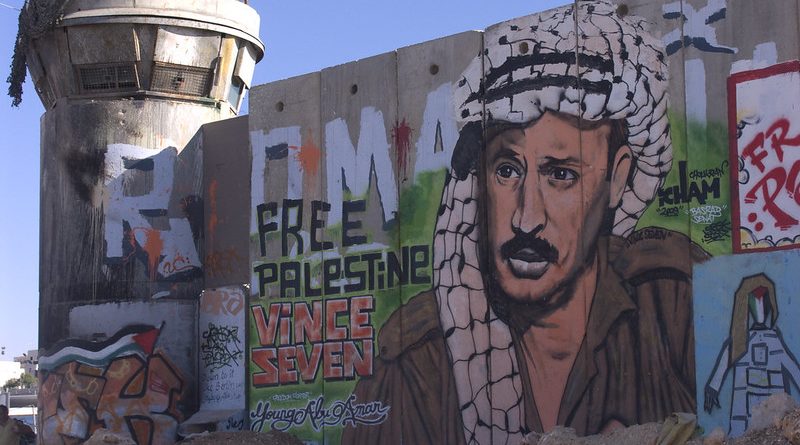A Short History of Palestine
The word Palestine derives from Philistia, the name given by Greek writers to the land of the Philistines, who in the 12th century BC occupied a small pocket of land on the southern coast, between modern day Tel Aviv and Gaza. The name was revived by the Romans in the 2nd century in “Syria Palaestina,” designating the southern portion of the province of Syria, and made its way into Arabic, where it has been used to describe the region at least since the early Islamic era.
After Roman times the name had no official status until after World War I and the end of rule by the Ottoman Empire, when it was adopted for one of the regions mandated to Great Britain.
Palestine has always been at the centre of the Christian, Moslem and Jewish worlds. It has been invaded and occupied by many empires including, in ancient times, the Babylonians, Assyrians, Persians and Romans.
An ancient home of the Jews , it was a battleground between Moslem and Christian armies during the Crusades .
After the armies of Islam conquered much of the Middle East in the 7th century the region known as Palestine gradually became home to a largely Moslem population .
The population was mostly Christian until 1187 when Saladin, led a military campaign against the Crusaders. He became Sultan of Egypt and Syria, and his conquests included Egypt, Syria, Upper Mesopotamia (north Iraq, northeastern Syria and southwestern Turkey), Hejaz, Yemen and into North Africa. Saladin took Palestine (and Jerusalem) from the Crusaders at the Battle of Hattin in 1187.
From the 1st to the 11th centuries the population of Palestine had been mostly Christian but from the 12th to the 14th century the majority shifted from Christians to Muslims.
The Ottoman Empire
By the 14th century, the Ottoman Empire took control of the entire region.In 1516, the Ottoman Empire, led by Sultan Selim I, conquered Palestine from the Mamluks, who had ruled the region for several centuries.
The Ottomans maintained control over the holy sites in Jerusalem, including the holy Moslem site , the Al-Aqsa Mosque, and the Christian Church of the Holy Sepulchre. They also regulated access to these sites and implemented various policies to manage religious affairs.
Under the Ottoman Empire, Jews and Christians enjoyed a significant degree of protection and autonomy, particularly within the framework of the Ottoman millet system which recognised religious communities as separate legal entities, allowing them to govern their own internal affairs, including religious, educational, and legal matters.During periods of Jewish persecution in Europe, particularly during the late 15th century and onward, the Ottoman Empire provided a relative haven for Jewish refugees.
During the late 19th and early 20th centuries, as nationalist sentiments grew across the region, Palestinian Arab nationalism also began to emerge.Intellectuals and elites in Palestine expressed a sense of identity and called for greater autonomy and self-governance.
In the early 20th century, the Zionist movement gained momentum, aiming to establish a Jewish homeland in Palestine. Jewish immigration increased, and Zionist organizations purchased land from local landowners, leading to tensions between Jewish and Arab communities.The end of the Ottoman Empire’s rule in Palestine came with the conclusion of World War I. Following the defeat of the Ottoman Empire, the region came under British control with the implementation of the British Mandate for Palestine in 1920.
British Mandate of Palestine
During the initial years of the mandate, tensions between Jewish and Arab communities emerged. The British faced challenges in balancing the interests and demands of both groups. In 1936, a widespread Arab revolt erupted, demanding an end to Jewish immigration and land sales to Jewish settlers. The revolt was eventually suppressed by the British, leading to increased restrictions on both Arab and Jewish activities. As Jewish immigration continued, especially in the years leading up to and following World War II, the Zionist movement gained momentum. Jewish settlements expanded, and tensions between Jewish and Arab communities escalated. The British government proposed a unified Palestine as a future country for both Arabs and Jews.. Revolts by numerous Jewish military groups including the King David bombing , heightened tensions .The British struggled to maintain control and peace, and in 1947, they decided to withdraw from Palestine.
Arab Israeli War of 1948
In 1947, the UN adopted a partition plan for a two-state solution in the remaining territory of the mandate. The plan was accepted by the Jewish leadership but rejected by the Arab leaders, and Britain refused to implement the plan. On the eve of final British withdrawal, the Jewish Agency for Israel, headed by David Ben-Gurion, declared the establishment of the State of Israel according to the proposed UN plan.
The Arab dide did not declare a state of its own and instead, together with Transjordan, Egypt, and the other members of the Arab League of the time, commenced military action resulting in the 1948 Arab–Israeli War.
During the war, Israel gained additional territories that were designated to be part of the Arab state under the UN plan. Egypt occupied the Gaza Strip, and Transjordan occupied and then annexed the West Bank.
Occupation and the 1967 Arab–Israeli War In 1964, when the West Bank was controlled by Jordan, the Palestine Liberation Organization was established there with the goal to confront Israel. The Palestinian National Charter of the PLO defines the boundaries of Palestine as the whole remaining territory of the mandate, including Israel. The Six-Day War in 1967, when Israel fought against Egypt, Jordan, and Syria, ended with Israel occupying the West Bank and the Gaza Strip, besides other territories.
The October 1974 Arab League summit recognised the PLO as the “sole legitimate representative of the Palestinian people” and reaffirmed “their right to establish an independent state .Then in the following month, the PLO was recognized by the UN General Assembly which granted them observer status as a “non-state entity” at the UN.
In November 1988 in Algiers, Yasser Arafat, as Chairman of the PLO, issued the Palestinian Declaration of Independence, which established the State of Palestine. A year after the signing of the Oslo Accords in 1993, the Palestinian National Authority (PNA) was formed to govern the West Bank, comprising 165 enclaves, and the Gaza Strip. After Hamas became the PNA parliament’s leading party in 2006, a conflict broke out between it and the Fatah party, leading to the Gaza Strip being taken over by Hamas in 2007 .
Following a failed attempt in 2011 to secure full United Nations member state status, the United Nations General Assembly voted in 2012 to recognize Palestine as a non-member observer state.




